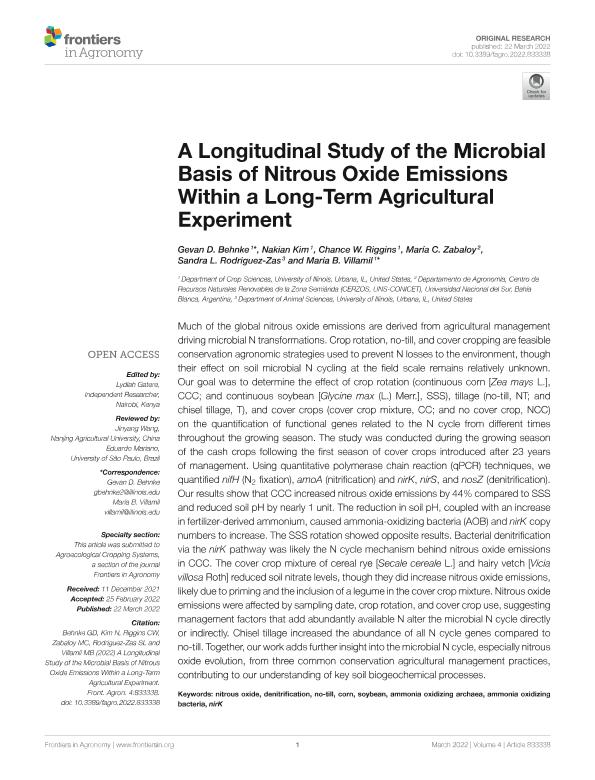Artículo
A Longitudinal Study of the Microbial Basis of Nitrous Oxide Emissions Within a Long-Term Agricultural Experiment
Behnke, Gevan D.; Kim, Nakian; Riggins, Chance W.; Zabaloy, Maria Celina ; Rodriguez Zas, Sandra L.; Villamil, Maria Bonita
; Rodriguez Zas, Sandra L.; Villamil, Maria Bonita
 ; Rodriguez Zas, Sandra L.; Villamil, Maria Bonita
; Rodriguez Zas, Sandra L.; Villamil, Maria Bonita
Fecha de publicación:
22/03/2022
Editorial:
Frontiers Media
Revista:
Frontiers in Agronomy
e-ISSN:
2673-3218
Idioma:
Inglés
Tipo de recurso:
Artículo publicado
Clasificación temática:
Resumen
Much of the global nitrous oxide emissions are derived from agricultural management driving microbial N transformations. Crop rotation, no-till, and cover cropping are feasible conservation agronomic strategies used to prevent N losses to the environment, though their effect on soil microbial N cycling at the field scale remains relatively unknown. Our goal was to determine the effect of crop rotation (continuous corn [Zea mays L.], CCC; and continuous soybean [Glycine max (L.) Merr.], SSS), tillage (no-till, NT; and chisel tillage, T), and cover crops (cover crop mixture, CC; and no cover crop, NCC) on the quantification of functional genes related to the N cycle from different times throughout the growing season. The study was conducted during the growing season of the cash crops following the first season of cover crops introduced after 23 years of management. Using quantitative polymerase chain reaction (qPCR) techniques, we quantified nifH (N2 fixation), amoA (nitrification) and nirK, nirS, and nosZ (denitrification). Our results show that CCC increased nitrous oxide emissions by 44% compared to SSS and reduced soil pH by nearly 1 unit. The reduction in soil pH, coupled with an increase in fertilizer-derived ammonium, caused ammonia-oxidizing bacteria (AOB) and nirK copy numbers to increase. The SSS rotation showed opposite results. Bacterial denitrification via the nirK pathway was likely the N cycle mechanism behind nitrous oxide emissions in CCC. The cover crop mixture of cereal rye [Secale cereale L.] and hairy vetch [Vicia villosa Roth] reduced soil nitrate levels, though they did increase nitrous oxide emissions, likely due to priming and the inclusion of a legume in the cover crop mixture. Nitrous oxide emissions were affected by sampling date, crop rotation, and cover crop use, suggesting management factors that add abundantly available N alter the microbial N cycle directly or indirectly. Chisel tillage increased the abundance of all N cycle genes compared to no-till. Together, our work adds further insight into the microbial N cycle, especially nitrous oxide evolution, from three common conservation agricultural management practices, contributing to our understanding of key soil biogeochemical processes.
Archivos asociados
Licencia
Identificadores
Colecciones
Articulos(CERZOS)
Articulos de CENTRO REC.NAT.RENOVABLES DE ZONA SEMIARIDA(I)
Articulos de CENTRO REC.NAT.RENOVABLES DE ZONA SEMIARIDA(I)
Citación
Behnke, Gevan D.; Kim, Nakian; Riggins, Chance W.; Zabaloy, Maria Celina; Rodriguez Zas, Sandra L.; et al.; A Longitudinal Study of the Microbial Basis of Nitrous Oxide Emissions Within a Long-Term Agricultural Experiment; Frontiers Media; Frontiers in Agronomy; 4; 22-3-2022; 1-17
Compartir
Altmétricas



